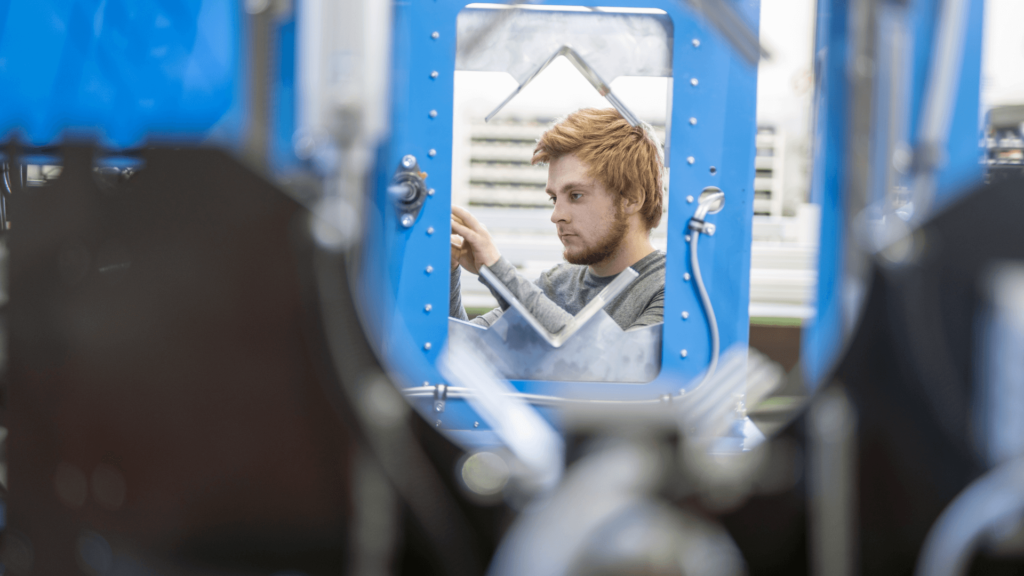The criteria for machine safety are changing as safety becomes an increasingly important determinant of quality. Responsibility for safety issues always lies with the employer who controls the use of the machine. Today, safe design also means investing in efficiency and usability.
Raimo Hevosmaa, a machine safety expert at Schmersal Finland, says that safety assessments are carried out with both equipment manufacturers and machine end-users in different industrial sectors.
– I have been working full-time as an expert since 2010, but I have more than 20 years of experience in the field of machine safety. I am usually called in by machine manufacturers when they don’t have the latest information on regulations or when they want an external expert to ensure that solutions are compliant. With Extron, I have worked with the latter. Their safety design is always at the highest level and combining safety with usability is the key factor, says Raimo.
Raimo visits end-users’ production facilities when safety issues are identified. Users do not always have the required know-how to improve or manage safety factors. Sometimes an accident has already happened, and the operator wants to work with an expert to find out how to solve the safety deficiencies.
– My third main role is to increase public knowledge. Nowadays, courses aimed directly at a specific client are quite common. Their content is tailored to the specific machine safety issues of interest to the customer, explains Raimo.
He points out that he never acts in the role of an authority, but as a guide and trainer, explaining how safety requirements can be met.
– I am always responsible to the client, whether it is the equipment manufacturer or the end user. I provide options and parameters within which to work to maximize safety. The most important thing is that the customer is given a clear picture of the steps that can be taken to meet the safety requirements to support their decisions.

Don’t take risks with safety regulations
Raimo summarizes that machinery safety legislation is basically divided into two categories. For the manufacturer or the distributor of the machinery, the legislation is uniform throughout the EU. The other category applies to the user of the machinery, i.e. the employer. It requires that only safe machinery is used on the site and that the employer manages the safety risks in the working environment.
Raimo underlines, that the primary responsibility for safety issues always lies with the employer. Unfortunately, he says, there are still even new machines that do not comply with the regulations. However, it is the employer’s responsibility to ensure that they are safe. Therefore, the knowledge of the frontline staff and the employer is of the utmost importance. Often, an external expert can provide end-users with not only useful information, but also reassurance and peace of mind.
On the machine manufacturer’s side, the requirements come directly from the Machinery Directives. These provisions are often general and binding and are implemented by means of harmonized standards. Standards are therefore very important for the manufacturer, as they define the detailed solutions for building safe machines.
– There are approximately 800 machine safety standards, from which the manufacturer must choose the standards that apply to each machine. There is some room for interpretation, so that new and better safety solutions can be developed. The true measure of professionalism is to offer new innovations within the framework of the existing standards, says Raimo.
The downside of a wide range of standards is that not all manufacturers are familiar with the regulations or aware of how they change.
– Even if everything was in order when the equipment was delivered, it doesn’t automatically mean that the machine is still compliant today. A risk assessment must always be carried out at regular intervals, especially in the event of modifications to the machine. If risks are identified, they should be addressed to meet the current safety requirements. Fortunately, a competent partner can offer modernization or design new, safer equipment, Raimo recalls.
How to ensure safety and usability
The customer can ensure that the machine is subject to a commissioning check at the latest at the commissioning stage. Safety issues will also be discussed during the inspection. Deviations may be easy to detect, but there may always be hidden risks. Fortunately, an expert knows when to look for hidden deviations. Deficiencies are often also noticeable in other matters, such as incomplete documentation or inappropriate markings on the machine.
– I cannot over emphasize the fact that employer responsibility is very heavy indeed. Self-awareness and self-audits are always in place when it comes to safety issues, but it’s also worth asking experts for help, Raimo highlights.
Choosing reliable partners with a strong track record is also always an investment in security.
– Extron has invested in safety at all stages of the machine’s lifecycle, without compromising on usability. They have worked hard to ensure that the machine is safe to use in all situations. For example, dangerous moving parts cannot be accessed without affecting the safety devices, Raimo praises.
According to Raimo, safety-oriented design is not at the expense of usability or efficiency, but quite the opposite. Safety is the basis for ensuring that machines and the entire production process operate reliably and without surprises.
– Professionals know how to consider all the needs of end users and operators, and safety is one of the biggest competitive advantages that is becoming increasingly important. Having an external sparring partner helps to increase the certainty that everything is in order and production is running as it should.
Extron will appear at the Ekstruusiopäivät (Extrusion days) event in Tampere on 22-23 May 2024. Come and hear and discuss safety issues in more detail!
